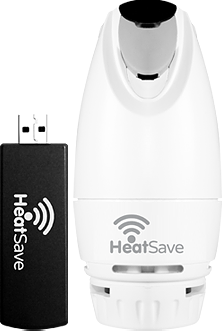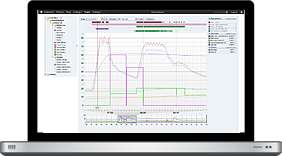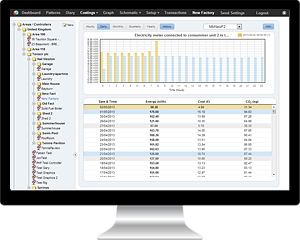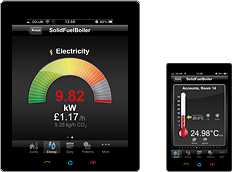Energy monitoring and the building performance gap
In 2013 the directors of Building Research Establishment (“BRE”) approached HeatingSave asking them to create a wireless Building Performance Monitor based on the HeatingSave Building Management System (BMS). They said HeatingSave was the ‘best in its class’ and they needed a BRE Monitoring System. Working closely with BRE, HeatingSave developed a low cost, plug & play energy monitoring system producing minute-by-minute data. This was able to determine the heat-loss coefficient of not only a building but individual rooms within a building.
The BRE Monitoring System was incorporated into the HeatingSave BMS system in 2016 to create the worlds 1st Building Energy Monitoring And Management system (“BEMAM”).
Portable plug & play monitoring
Today, the HeatingSave Monitoring System is sold as a separate wireless Zig 2.4 GHz wireless mesh network based Building Performance Monitoring tool, and, is also incorporated within the HeatingSave BEMAM system.
Energy Performance Gap
It’s long been known that the calculated energy use and environmental conditions within buildings when they are designed can vary significantly with the actual energy and conditions measured when the building is used. This is also true with regard to SAP and SBEMS calculations/assumptions. The causes for this include; materials not to standard, poor/unchecked construction techniques, post occupancy repairs/renewals and occupant lifestyles and behaviour.
In-building monitoring
The HeatingSave Energy Monitoring System enables the different stakeholders involved in delivering and applying energy efficiency measures to fully understand their impact and influence. It allows stakeholders to answer critical questions as follows:
Client – are the solutions provided fit for purpose and able to deliver promised outcomes?
Developer / Contractor – is there a gap between theoretical and actual performance when delivering new or refurbished works?
Supplier – does the product perform as specified?
Financier – are savings that are integral to your financial models being delivered?
Users – how does your behaviour affect your building’s performance?
How it works
The HeatingSave Energy Monitoring wireless management system collects information from sensors placed within a building. It is unobtrusive and causes minimal disruption during installation – a great system for a temporary or permanent retrofit.
The system collects internal and external temperature data, along with information on how the heating system works and details of energy use. It also monitors air quality including carbon dioxide, relative humidity, volatile organic compound levels and the way a building is used in terms of its occupancy, light and sound levels and the occupants’ activities and lifestyles.
Using a password protected standard internet connection, sensors can quickly be set up to review and quantitatively analyse the data with user-friendly software graphics, via a laptop, PC, mobile phone or tablet-based device. It provides a clear understanding of the real impact of energy efficiency measures, for example through pre-installation analysis and post-installation monitoring. For the 1st time you will see real cause & effect.
Building owners and managers can access their energy usage details online to help them manage energy use more efficiently. This information is presented using a dashboard system that provides consolidated and drill down views of the energy use data.
- Temperature data – Wireless temperature sensors, using the 2.4GHz wireless mesh network technology (HA protocol), gathers data from the building every minute. Unobtrusive room sensors measure living temperatures throughout the building, whilst a weather-proof sensor placed on an outer wall measures the ambient temperature outside.
Where applicable, boiler flow and return temperatures are measured using stainless steel probe sensors, tie-wrapped onto boiler pipes. Probe sensors for hot water cylinders and wall surface sensors are also used when required. - Air Quality – Relative Humidity (“RH”), Carbon Dioxide (“CO2”), Volatile Organic Compounds (“VOC”) sensors in various rooms measure and record data similar to temperature sensors.
- Living Conditions: Occupancy, light and sound level Zig 2.4GHz wireless mesh network based sensors measure the general environment where people live and work, whilst the new heat-flux sensors measure the U value at various points within the building fabric. RH, CO2 and VOC concentrations each minute correlated with Air Quality and Living Conditions gather in-use data. From this data the software is able to analyse actual performance to determine the cause-and-effect on a variety of construction materials and products matched with the lifestyles of the occupants.
- Energy and Utility data: Pulse counting sensors accurately measure each minute the electricity, gas, oil and water consumed via the same 2.4GHz wireless mesh network. The HeatingSave Monitor software converts this information into kilowatt-hours (kWh) and calculates the notional CO2 emissions for each of the fuel sources. Using the internet building owners can analyse use and costs as they happen.
Where is it used
- Housing Stock – Owners, managers, RSL’s and assessors can use the HeatingSave Energy Monitor to help with energy efficiency improvement schemes. These include the energy supplier funded, ECO scheme for improving housing insulation and in proving measures under the Every Home Matters scheme to prove KwH savings for funding energy efficiency improvements.
- Commercial Buildings – Multiple boiler systems, air conditioning, lighting, and solar PV, solar thermal and biomass energy systems can all be monitored.
- Portfolios – Powerful web server data collection software is capable of monitoring and analysing very large building portfolios with this “big data” system.
What’s included?
At the heart of the HeatingSave Energy Monitor is the Hub, a high-performance, low-power 1GHz Samsung ARM Cortex-A8 processor to provide the computing power for the Linux based software system. Its compact design allows it to be quickly accessed via the web
To each Hub you can add 100’s of wireless sensors of all types, even our wireless TRV’s to provide a complete building monitoring system, only buying the sensors that you need.
Who uses it?
Well, the BRE have used the HeatingSave Energy Monitor in a number of their projects and they have a demonstration system in their Energy House in Watford. The system has also been used by a number of universities on the forefront of building physics such as Leeds Beckett, Salford and Newcastle.
Energy Performance Challenge (EPC)
The HeatingSave Energy Monitor was the monitoring system selected by Knauf Insulation and BRE for the Energy Performance Challenge project in Salford that runs from August 2014 to April 2017. This is one of, if not the largest in-depth, studies of “before and after energy improvement measures” ever undertaken in the UK. To date it covers 83 properties with 2,728 sensors and has collected 569,196,123 transactions. This “big data” is being analysed by a number of world-renowned organisations including Cambridge Energy.
If you have a monitoring project – look no further than HeatingSave for your monitoring needs.
Related Testimonial
Related Case Studies
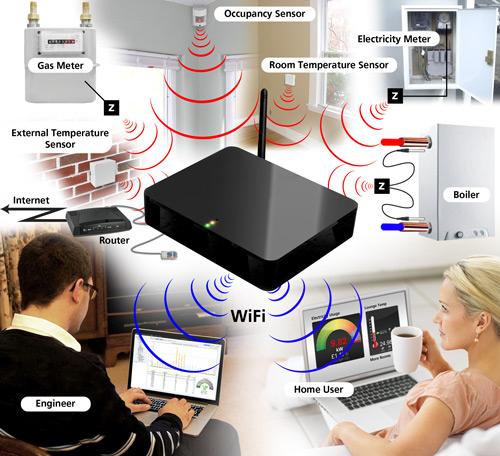
Technical Specifications
- Processor – Samsung ARM 1GHz Cortex-A8
- Memory – 512MB DDR2
- Flash – 256MB SLC NAND Flash, 8GB micro SDHC class 10
- Energy Saving – Monolithic integrated power management chip
- Power – Max 3W
- Wifi – 802.11 b/g/n
- Zig 2.4 Mhz wireless mesh network Wireless Technology
Product Dimensions
Width – 162mm Depth – 132mm Height – 36mm


